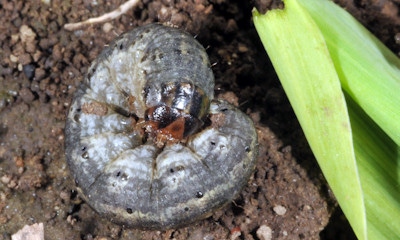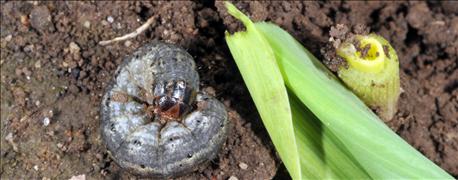
Black cutworms are the kind of pest that doesn't hit every year, but when they do they can cause considerable damage. They also don’t tend to wipe out whole fields, but can do a number on big areas within a field.
Here are 4 things you should know to lessen the odds that black cutworms will munch on your fields. Some information comes from the Purdue University Corn & Soybean Field Guide. Other information was provided by Christian Krupke and John Obermeyer, in the second edition of the 2016 Pest & Crop Newsletter - and you can find a link to their newsletter at the end.
1. The bad news - some moths arrived early from the Gulf States

BLACK CUTWORMS WILL ARRIVE: The late freeze may have killed moths already here, but it won’t prevent more black cutworm moths from coming in. Here is a black cutworm after it cut a plant. (photo courtesy of John Obermeyer, Purdue entomology)
Purdue entomologists have an organized network of crop scouts and others who put out pheromone traps to attract moths. Then they report the data weekly, and it’s summarized. Moths began to show up in traps in late March in some parts of the state. They overwinter near the Gulf, and ride storm fronts from the southwest into Indiana.
2. The good news - Most of those early moths or the eggs they laid likely didn’t survive
The cold outbreak across the state during the first week of April likely took out those moths, and any eggs they might have already laid, Purdue entomologists say. That’s because they are vulnerable to freezing temperatures. It’s why they don’t overwinter well in Indiana in the first place. Instead, they overwinter in the southern U.S. where it’s warmer. Then moths fly up on air currents each spring.
3. Reality - More moths are coming this way.
The entomologists note that more moths will come up on air currents as storms track northwest into Indiana. The early April freeze may have delayed or prevented an early onset of black cutworm issues, but it won’t prevent it. More moths will come this direction. Moths coming in are characterized by black forewings, with a distinct ‘black dagger’ marking on each forewing.
4. Watch for moth trap catch information in your area.
The Pest @ Crop Newsletter published electronically by the Purdue Entomology Department has updates on moth catches from the network of observers around the state. Once moth report numbers are known, entomologists can use formulas based on heat unit accumulation and offer guidance on when black cutworm larvae are likely to hatch. Access the newsletter at: extension.entm.purdue.edu/pestcrop/2016/Isssue2/
About the Author(s)
You May Also Like




